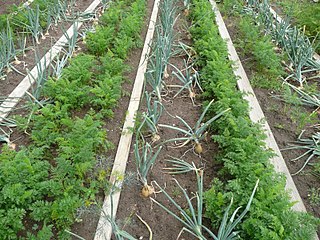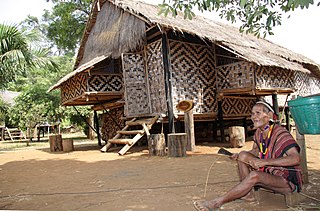
Laos, officially the Lao People's Democratic Republic, is the only landlocked country in Southeast Asia. At the heart of the Indochinese Peninsula, Laos is bordered by Myanmar and China to the northwest, Vietnam to the east, Cambodia to the southeast, and Thailand to the west and southwest. Its capital and largest city is Vientiane.

The economy of Laos is a lower-middle income developing economy. Being one of the socialist states, the Lao economic model resembles the Chinese socialist market and/or Vietnamese socialist-oriented market economies by combining high degrees of state ownership with openness to foreign direct investment and private ownership in a predominantly market-based framework.

Companion planting in gardening and agriculture is the planting of different crops in proximity for any of a number of different reasons, including weed suppression, pest control, pollination, providing habitat for beneficial insects, maximizing use of space, and to otherwise increase crop productivity. Companion planting is a form of polyculture.

Erythrina is a genus of plants in the pea family, Fabaceae. It contains about 130 species, which are distributed in tropical and subtropical regions worldwide. They are trees, with the larger species growing up to 30 m (98 ft) in height. The generic name is derived from the Greek word ερυθρóς erythros, meaning "red", referring to the flower color of certain species.
The Nam Ngum Dam is a hydroelectric dam on the Nam Ngum River, a major tributary of the Mekong River in Laos. It was the first hydropower dam built in the Lao PDR.

Lao-Lao is a Laotian rice whisky produced in Laos. Along with Beerlao, lao-Lao is a staple drink in Laos.

Shade-grown coffee is a form of the crop produced from coffee plants grown under a canopy of trees. A canopy of assorted types of shade trees is created to cultivate shade-grown coffee. Because it incorporates principles of natural ecology to promote natural ecological relationships, shade-grown coffee can be considered an offshoot of agricultural permaculture or agroforestry. The resulting coffee can be marketed as "shade-grown".
Since the first HIV/AIDS case in the Lao People's Democratic Republic (PDR) was identified in 1990, the number of infections has continued to grow. In 2005, UNAIDS estimated that 3,700 people in Lao PDR were living with HIV.

Laos produces two main types of coffee: Robusta and Arabica. Robusta is mainly used for regular coffee as well as a typical coffee drink in Laos where it is sweetened with condensed milk. The latter, Arabica, is of a higher quality due to its mild taste, and it is used for espresso. For the 20,000 tons of coffee that Laos produces a year, 5,000 tons are Arabica beans and 15,000 tons are Robusta.

Pterocarpans are derivatives of isoflavonoids found in the family Fabaceae. It is a group of compounds which can be described as benzo-pyrano-furano-benzenes which can be formed by coupling of the B ring to the 4-one position.

Phaseolin is a prenylated pterocarpan found in French bean seeds and in the stems of Erythrina subumbrans.
The molecular formula C20H18O4 may refer to:
The Houay Ho is a dam located in Samakkhixay District of Attapeu Province, Laos, 160 km (99 mi) east of Pakse and 30 km (19 mi) northwest of Attapeu. The project is considered the first privately financed joint venture 'build-operate-transfer' (BOT) hydropower project in Laos. It has installed capacity of 152.1 megawatts (204,000 hp), almost all of which is exported to Thailand.
This page describes energy and electricity production, consumption and import in Laos.

Sekong is a province of Laos in the southeast of the country.

Salavan is a province of Laos, located in the south of the country. Its earlier name was Saravan which was changed by the Thais to Salavan in 1828. It was part of the Champasak Kingdom in an area known as Muang Mang inhabited by minorities of Mon-Khmer groups.

Visitors to Laos must obtain a visa from one of the Laotian diplomatic missions unless they are citizens of one of the visa-exempt countries or citizens eligible for a visa on arrival or an e-Visa. All visitors must hold a passport valid for 6 months.

Alexandra Bounxouei is a Laotian–Bulgarian singer, actress and model who is popular in Laos, Thailand and the south-east Asia countries. She is the first UNDP's Goodwill Ambassador for Lao PDR since 2013.
Platypria (Platypria) hystrix, is a species of leaf beetle found in India, China, Indonesia, Myanmar, Nepal, Sri Lanka, Thailand and Vietnam.

Platypria (Platypria) echidna, is a species of leaf beetle found India, Sri Lanka, Myanmar and Vietnam.













